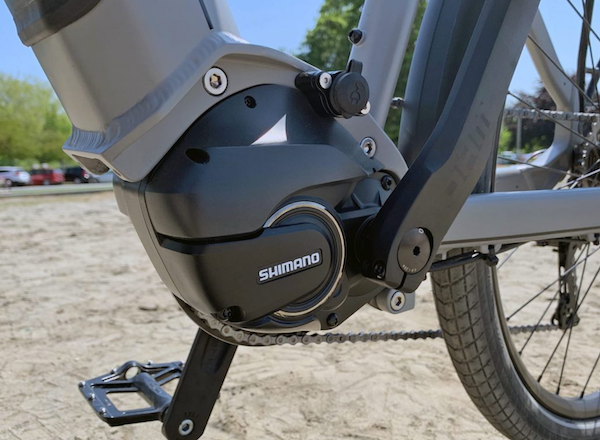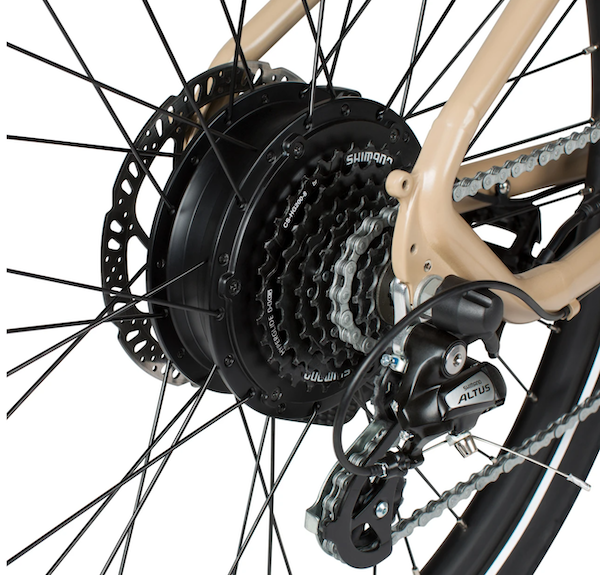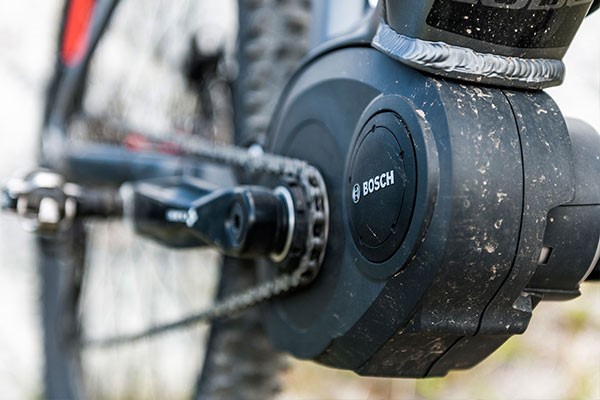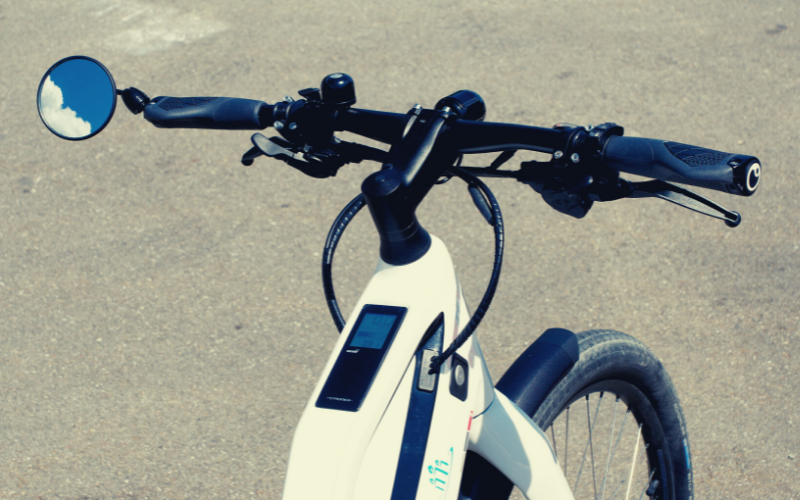When it’s time to pick out an e-bike, there are some important details to consider in the design and build of the bike you choose. Electric bikes come in many shapes, styles, and sizes, so it’s good to take some time to understand more about your riding goals and needs as you learn about your many options among the choices in the modern e-bike market.
One important question is which type of motor you prefer. The electric motor is what sets an e-bike apart from a standard bicycle, of course. However, there are two different types of motors to consider:
Mid-drive motor: A small electric motor is built into the bottom bracket, where the cranks that you pedal connect to turn the chain.
Hub-mounted or direct drive motor: A small electric motor is fit into either the front or more often, rear-wheel hub — in the center of the wheel where it mounts to the bike.
While both motor types are meant to be out of the way, basically out of sight to the rider, and both do the same job of adding some power to your pedaling, the difference in design can have a big impact on the feel and performance of your electric bicycle. There are some important differences in weight, power delivery, appearance, and more. If possible, it’s worth doing some test riding to get a feel for your favorite style.
How It Works: Mid-Drive Motor
The bottom bracket holds the cranks that you turn with your feet every time you pedal your bike. It’s a natural place to put a motor because the components used for turning the chain to make the wheel go round already sit right there, so adding in some machinery for boosting the power that turns the chain makes perfect sense. But, an electric motor is larger than the standard crankset that has occupied that spot for decades in traditional bike design, so a custom frame is required to hold a motor there. The extra costs of engineering the frame and drivetrain (the crankset and chain) to fit in a small motor (and battery) add extra costs and an average higher price for a mid-drive motor system.

Mid-drive motors are known for smooth power assist delivery because it comes from the place where you’re already applying power to turn the cranks. The sensor that tells the motor how much power to give is built right into the heart of your pedaling, and can more accurately and sensitively measure the pressure, or torque, that you are putting on the pedals to supplement that effort with electric power smoothly.
But, because the motor puts a lot more pressure, more constantly, on the crankset and the drivetrain, mid-drive e-bikes are more likely to have a breakdown in that area. Some mid-drive motors may be matched with a more sturdy belt drive instead of the standard chain, which may help the drivetrain last longer despite the direct stress of the motor on the crankset. Partly because of added stress on the chain, mid-mount motors tend to be on the lower end of the power range, from 250 W to 500 W, and so they are often lighter than hub-mount motors. But, since they deliver their power more efficiently, it’s generally possible to get similar performance from a lower-powered motor.
The sleek Veloretti e-bikes, the rugged Dutch Gazelle e-bikes, and the reasonably priced newcomers on the market, Buzz Bikes, as well as many styles and types of e-bikes on offer in the current market, are all examples of different styles of bikes that feature a mid-drive motor.
Ups & Downs Of Mid-Drive Motors
Upside:
- Typically smoother power delivery, with torque sensor that measures your pedal power;
- Easier for routine tire maintenance, as the motor is out of the way of wheels for changing flats or tightening spokes, for example;
- Often lighter-weight than hub-mount models;
- Easier to conceal motor and battery, so it looks less obviously like an e-bike;
- Generally better performance under stress such as uphills because it can change the gear ratio, unlike hub-motors;
- Can give more riding range with more efficient power delivery.
Downside:
- More moving parts can lead to more likelihood of breakdowns;
- It May be more difficult to service, as the motor is contained within the bottom bracket;
- Likely to be more expensive because a custom frame and different technology is needed;
- The extra pressure that is directly applied to the drivetrain can cause quicker wear and tear and need repairs more often.
How It Works: Hub-mounted Motor

A hub motor can go in the center of the front or back wheel, where it applies direct turning force to the wheel. The result is a slight sense of being pulled along with the less-common front hub motor or pushed forward with the more-common rear hub motor. Rear hub motors are the leading design in the current e-bike market, and they can better handle the most powerful motors, up to 750 W (1 hp), a legal limit in the US for an e-bike to avoid being classed as a motorized vehicle.
Since the hub is right where the wheel mounts to the bike, it is a bit more complicated to remove the wheel to replace a flat, and it can be very difficult to adjust the spokes to keep the wheel in proper alignment. The weight distribution of the bike is also much more affected by the weight of the motor, which can range from six to ten pounds (2.7 – 4.5 kg) or more, sitting in the middle of the rotating front or rear wheel, rather than centered low in the middle of the bike frame. Steering can take some getting used to on a front hub e-bike, especially.
Some examples of rear hub motor e-bikes include the very popular Super73 mini bikes that have been seen zooming all over social media, the Zooz Urban Ultralight, as well as all the models in Aventon’s e-bike lineup. Currently, the rear-hub mount motor is the most popular design in e-bikes.
Front-hub mounted motors are less widely used, partly because of the altered weight balance. Front motors also are more likely to spin out when you hit the throttle to take off, as the front wheel has the least amount of weight pressing down on it. And since one of the heaviest pieces of an e-bike, the electric motor, sits inside the spinning gyro of the front wheel, the balance is different.
When properly balanced, as in the VanMoof X3 and S3 models, with the nearly equal weight of a battery in the rear of the bike for stability, for example, a front mount e-bike can be very stable and enjoyable to ride. Some riders notice the sense of being ‘pulled’ by a front mount motor, but these different sensations even out somewhat as you get up to speed on your ride.
Ups & Downs Of Hub Motors
Upside:
- The small electric motor fits neatly into the front or back wheel, saving space in the frame;
- Being somewhat simpler to fit into the bike and more widely used, hub motor e-bikes tend to be cheaper than mid-drive bikes;
- Less stressful on the drivetrain, especially front-hub motors that don’t interact with the chain and gears at all;
- Hub motors continue to function uninterrupted if there is a problem with the chain, as they put power directly through the wheel to the ground.
Downside:
- Weight distribution isn’t ideal with a heavy electric motor in the center of a spinning wheel, especially in the front, and hub motors are bigger and heavier, but also more powerful than mid-drive motors;
- Harder to do routine maintenance on wheels and tires, from flat tire repairs to adjusting the spokes, if you’ve got to deal with the motor when you take the wheel off;
- Power delivery direct to tire versus in the center of the drivetrain can give less even and smooth power delivery.
Wrap Up
So, you’ve got a choice to make when it’s time to choose an e-bike. In a packed-full market with quality e-bikes available at all prices and quality ranges, though, you can be certain to find an e-bike that fits your style. There are some trade-offs with either choice of motor placement, of course, involving critical performance issues like weight balance and stability (more of an issue with front hub-mount motors), smooth and even delivery of power to supplement your pedaling, and questions of mechanical wear and tear and repairs.
It’s best to take some test rides with various bikes that are set up with these different types of motors to get a feel for your preference. This is sometimes easier said than done, though, as many companies offer a direct-to-consumer, web-based order, and delivery model rather than a network of dealers. Some companies will give you a test ride with a loaner bike that they’ll deliver, or you can go to your nearest good-sized city to check out some dealers who carry the models you’re interested in to try before you buy.





